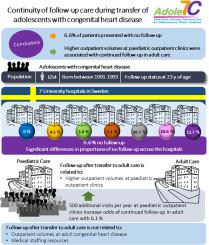当前位置:
X-MOL 学术
›
Int. J. Cardiol.
›
论文详情
Our official English website, www.x-mol.net, welcomes your
feedback! (Note: you will need to create a separate account there.)
Outpatient volumes and medical staffing resources as predictors for continuity of follow-up care during transfer of adolescents with congenital heart disease.
International Journal of Cardiology ( IF 3.2 ) Pub Date : 2020-01-17 , DOI: 10.1016/j.ijcard.2020.01.016 Sandra Skogby 1 , Philip Moons 2 , Bengt Johansson 3 , Jan Sunnegårdh 4 , Christina Christersson 5 , Edit Nagy 6 , Per Winberg 7 , Katarina Hanséus 8 , Aleksandra Trzebiatowska-Krzynska 9 , Shalan Fadl 10 , Eva Fernlund 11 , Kalliopi Kazamia 12 , Annika Rydberg 13 , Liesl Zühlke 14 , Eva Goossens 15 , Ewa-Lena Bratt 16
International Journal of Cardiology ( IF 3.2 ) Pub Date : 2020-01-17 , DOI: 10.1016/j.ijcard.2020.01.016 Sandra Skogby 1 , Philip Moons 2 , Bengt Johansson 3 , Jan Sunnegårdh 4 , Christina Christersson 5 , Edit Nagy 6 , Per Winberg 7 , Katarina Hanséus 8 , Aleksandra Trzebiatowska-Krzynska 9 , Shalan Fadl 10 , Eva Fernlund 11 , Kalliopi Kazamia 12 , Annika Rydberg 13 , Liesl Zühlke 14 , Eva Goossens 15 , Ewa-Lena Bratt 16
Affiliation

|
BACKGROUND
Providing continuous follow-up care to patients with congenital heart disease (CHD) remains a challenge in many settings. Previous studies highlight that patients with CHD experience discontinuation of follow-up care, but mainly describe a single-centre perspective, neglecting inter-institutional variations. Hospital-related factors above and beyond patient-related factors are believed to affect continuity of care. The present multicentre study therefore investigated (i) proportion of "no follow-up care"; (ii) transfer destinations after leaving paediatric cardiology; (iii) variation in proportions of no follow-up between centres; (iv) the association between no follow-up and outpatient volumes, and (v) its relationship with staffing resources at outpatient clinics.
METHODS
An observational, multicentre study was conducted in seven university hospitals. In total, 654 adolescents with CHD, born between 1991 and 1993, with paediatric outpatient visit at age 14-18 years were included. Transfer status was determined 5 years after the intended transfer to adult care (23y), based on medical files, self-reports and registries.
RESULTS
Overall, 89.7% of patients were receiving adult follow-up care after transfer; 6.6% had no follow-up; and 3.7% were untraceable. Among patients in follow-up care, only one remained in paediatric care and the majority received specialist adult CHD care. Significant variability in proportions of no follow-up were identified across centres. Higher outpatient volumes at paediatric outpatient clinics were associated with better continued follow-up care after transfer (OR = 1.061; 95% CI = 1.001 - 1.124). Medical staffing resources were not found predictive.
CONCLUSION
Our findings support the theory of hospital-related factors influencing continuity of care, above and beyond patient-related characteristics.
中文翻译:

门诊病人数量和医务人员资源是先天性心脏病青少年转移期间随访服务连续性的预测指标。
背景技术在许多情况下,向患有先天性心脏病(CHD)的患者提供连续的随访护理仍然是一个挑战。先前的研究强调患有冠心病的患者会中断后续治疗,但主要描述的是单中心观点,忽略了机构间差异。人们认为,超出患者相关因素的医院相关因素会影响护理的连续性。因此,目前的多中心研究调查了(i)“无后续护理”的比例;(ii)离开小儿心脏病学后的目的地;(iii)各中心之间没有后续行动的比例有所不同;(iv)无随访量和门诊量之间的关联,以及(v)与门诊人员资源的关系。方法观察性 在七所大学医院进行了多中心研究。总的来说,包括1991年至1993年之间出生的654名患有CHD的青少年,其门诊时间为14-18岁。根据医疗档案,自我报告和登记表,在计划转移至成人护理5年后(23y)确定转移状态。结果总体上,有89.7%的患者在转移后接受成人随访护理。6.6%没有随访;和3.7%是无法追踪的。在接受后续治疗的患者中,只有一名仍留在儿科护理中,大多数接受了成人CHD专科护理。各个中心之间没有随访的比例存在显着差异。儿科门诊门诊量增加与转移后更好的持续随访护理相关(OR = 1.061; 95%CI = 1.001-1.124)。医务人员配置资源无法预测。结论我们的发现支持了影响患者连续性的医院相关因素的理论,超出了患者相关特征。
更新日期:2020-01-17
中文翻译:

门诊病人数量和医务人员资源是先天性心脏病青少年转移期间随访服务连续性的预测指标。
背景技术在许多情况下,向患有先天性心脏病(CHD)的患者提供连续的随访护理仍然是一个挑战。先前的研究强调患有冠心病的患者会中断后续治疗,但主要描述的是单中心观点,忽略了机构间差异。人们认为,超出患者相关因素的医院相关因素会影响护理的连续性。因此,目前的多中心研究调查了(i)“无后续护理”的比例;(ii)离开小儿心脏病学后的目的地;(iii)各中心之间没有后续行动的比例有所不同;(iv)无随访量和门诊量之间的关联,以及(v)与门诊人员资源的关系。方法观察性 在七所大学医院进行了多中心研究。总的来说,包括1991年至1993年之间出生的654名患有CHD的青少年,其门诊时间为14-18岁。根据医疗档案,自我报告和登记表,在计划转移至成人护理5年后(23y)确定转移状态。结果总体上,有89.7%的患者在转移后接受成人随访护理。6.6%没有随访;和3.7%是无法追踪的。在接受后续治疗的患者中,只有一名仍留在儿科护理中,大多数接受了成人CHD专科护理。各个中心之间没有随访的比例存在显着差异。儿科门诊门诊量增加与转移后更好的持续随访护理相关(OR = 1.061; 95%CI = 1.001-1.124)。医务人员配置资源无法预测。结论我们的发现支持了影响患者连续性的医院相关因素的理论,超出了患者相关特征。











































 京公网安备 11010802027423号
京公网安备 11010802027423号